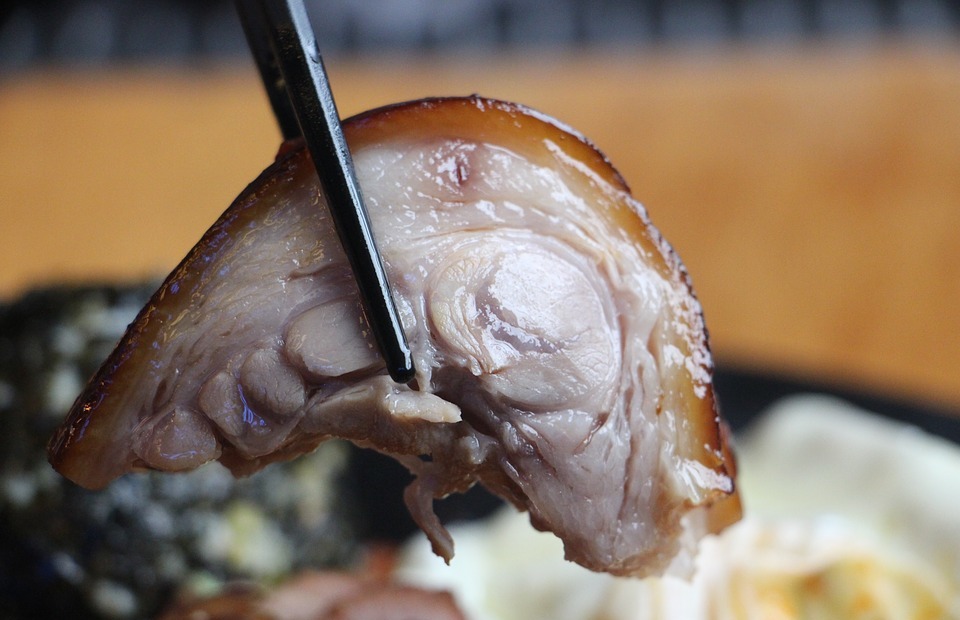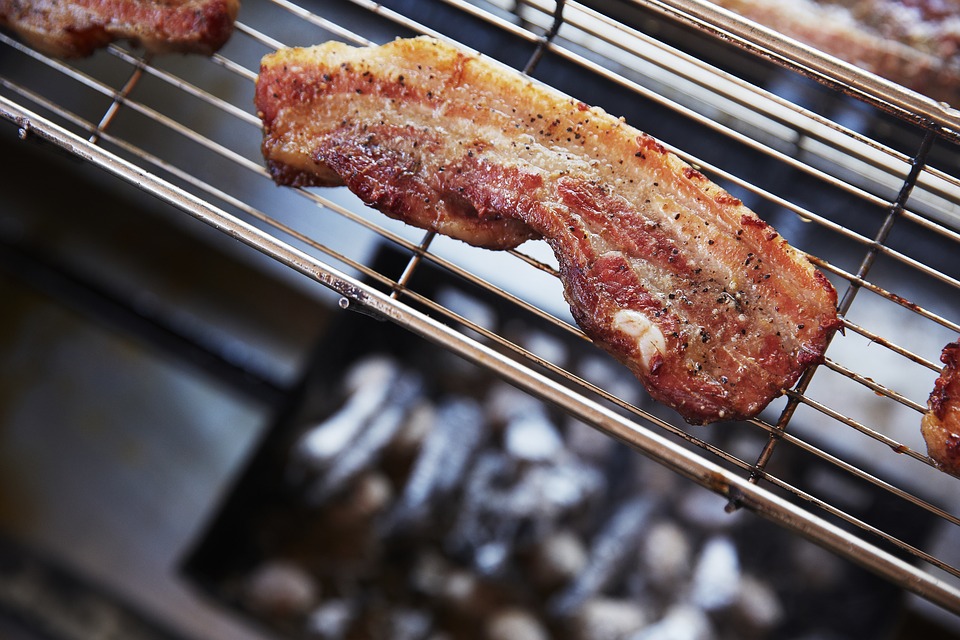This article explores the complex relationship between dogs and pork, providing a comprehensive guide to the safety, risks, and considerations involved in feeding pork to your canine companion. We'll delve into the nutritional value of pork, potential dangers, cooking methods, and how to identify safe pork products for your dog. We'll also address common questions regarding pork and dogs, ensuring you have all the information you need to make informed decisions about your furry friend's diet.
Part 1: Understanding Pork and Dogs

1.1 Nutritional Value of Pork
- Protein: Pork is a rich source of high-quality protein, essential for muscle growth and repair in dogs. It provides essential amino acids, including lysine, which is crucial for tissue growth and development. The protein content in pork can vary depending on the cut, with leaner cuts like loin and tenderloin containing more protein than fatty cuts.
- Essential Fatty Acids: Pork contains healthy fats like linoleic acid, crucial for skin and coat health. Linoleic acid is an omega-6 fatty acid that helps maintain a healthy skin barrier and promotes a glossy, shiny coat. It also plays a role in reducing inflammation and supporting overall skin health.
- Vitamins and Minerals: Pork provides essential vitamins (B vitamins, vitamin E) and minerals (iron, zinc, potassium) for overall well-being. Pork is a good source of thiamin (vitamin B1), niacin (vitamin B3), and vitamin E, which are antioxidants that protect cells from damage. It also provides iron, which is essential for oxygen transport in the blood, and zinc, which supports immune function and wound healing.
1.2 Potential Risks of Feeding Pork to Dogs
- Food Allergies: Some dogs may exhibit allergies to pork, leading to symptoms like skin irritation, digestive upset, and vomiting. Pork allergies are relatively common in dogs, and symptoms can vary in severity. If you suspect your dog has a pork allergy, it's crucial to consult with your veterinarian.
- Fat Content: Pork is high in fat, which can contribute to weight gain and pancreatitis in overweight dogs. The fat content in pork varies depending on the cut, with fatty cuts like belly and shoulder containing more fat than lean cuts. It's important to choose lean cuts of pork and feed them in moderation to prevent weight gain and health problems.
- Parasites: Raw pork can harbour parasites like Trichinella spiralis, which can cause health issues in dogs. Trichinella spiralis is a parasitic roundworm that can cause trichinosis, a disease that can affect the muscles, heart, and lungs. Thorough cooking eliminates the risk of parasites, making cooked pork safe for dogs.
- Bones: Cooked pork bones can splinter, posing a choking hazard or causing internal injuries. Bones, whether raw or cooked, can splinter and cause serious damage to a dog's digestive system. It's best to avoid giving bones to dogs altogether, as they pose a significant risk. Instead, opt for safe and digestible treats like cooked meat, vegetables, or commercially available dog chews.
Part 2: Safe Pork for Dogs

2.1 Cooked Pork
- Thorough cooking eliminates parasites and reduces the risk of foodborne illnesses. Cooking pork to an internal temperature of at least 160°F (71°C) ensures that any potential parasites are killed. This temperature is sufficient to eliminate Trichinella spiralis and other harmful bacteria that may be present in raw pork.
- Cook pork to an internal temperature of at least 160°F (71°C) to ensure safety. Use a meat thermometer to check the internal temperature of the pork. The thermometer should be inserted into the thickest part of the meat, ensuring that the temperature reaches the safe minimum of 160°F (71°C).
- Avoid feeding raw or undercooked pork to dogs. Raw pork poses a significant risk of parasites and foodborne illnesses, so it's essential to cook pork thoroughly before feeding it to your dog.
2.2 Pork Products
- Commercial Dog Food: Many dog food brands incorporate pork or pork by-products as ingredients. Choose high-quality brands with reputable sourcing practices. When selecting commercial dog food, look for brands that use high-quality ingredients and have a good reputation for safety and quality control. Check the ingredients list to ensure that the pork used is sourced responsibly and has been properly processed.
- Pork Treats: Commercially available pork treats can be a healthy and tasty option, but ensure they are free from artificial ingredients and preservatives. Choose treats that are specifically formulated for dogs and avoid those containing added sugars, salts, or artificial colours and flavours. Read the ingredient list carefully and select treats with natural ingredients.
- Homemade Pork Meals: Cooked, lean pork can be incorporated into homemade dog food recipes, but it's essential to consult with a veterinarian to ensure nutritional balance. If you choose to make your own dog food, it's crucial to consult with a veterinarian or a certified canine nutritionist to ensure that the recipe is balanced and meets your dog's nutritional needs. A balanced homemade diet should include protein, carbohydrates, fats, vitamins, and minerals in appropriate proportions.
2.3 Safe Preparation
- Remove Fat: Trim excess fat from pork before cooking, as it can be detrimental to your dog's health. The fat content in pork can vary, and excessive fat can contribute to weight gain, pancreatitis, and other health issues in dogs. Trimming the fat before cooking helps reduce the overall fat content and makes the pork healthier for your dog.
- Avoid Seasonings: Avoid using salt, garlic, onions, and other spices that can be harmful to dogs. Opt for plain, cooked pork. Salt can be detrimental to a dog's health, especially in large quantities. Garlic and onions contain compounds that can damage red blood cells and cause anemia in dogs. It's best to avoid using these seasonings when cooking pork for your dog.
- Proper Storage: Refrigerate cooked pork properly to prevent spoilage. Avoid leaving it out at room temperature for extended periods. Refrigerate cooked pork within two hours of cooking. Store it in an airtight container in the refrigerator for up to three to four days. Freezing cooked pork can extend its shelf life for up to two to three months.
Part 3: Identifying Safe Pork

3.1 Look for Labels
- "Human Grade": This label indicates that the pork is safe for human consumption, suggesting high quality and safety standards. Human-grade pork meets strict safety regulations and is processed in a manner that ensures it's free from contaminants and harmful bacteria. This label provides a good indication of the quality and safety of the pork product.
- "USDA Inspected": The USDA inspection mark ensures that the pork meets certain safety and quality requirements. The USDA inspection process involves verifying the cleanliness of the processing facility, inspecting the meat for safety hazards, and ensuring that the pork meets specific quality standards. The USDA inspection mark signifies that the pork product has passed these checks and meets the required safety criteria.
- "No Added Hormones": While pork naturally contains hormones, some producers use synthetic hormones. This label indicates the absence of such additives. Some consumers prefer pork that doesn't contain added hormones, as they believe it is safer and healthier. The "No Added Hormones" label ensures that the pork product has not been treated with synthetic hormones.
3.2 Ask Your Veterinarian
- Consult your veterinarian to discuss the appropriate amount and type of pork for your dog, considering their age, breed, and health status. Your veterinarian can provide personalized recommendations based on your dog's individual needs. They can advise you on the appropriate frequency and quantity of pork to include in your dog's diet, taking into account their age, weight, activity level, and any pre-existing health conditions.
- They can provide personalized recommendations and address any concerns you may have. Your veterinarian can also address any concerns you may have about feeding pork to your dog. They can provide valuable information on potential risks and benefits, as well as safe preparation and feeding practices.
Part 4: Common Questions and Answers
4.1 Can Dogs Eat Cooked Bacon?
While bacon can be tempting, it's not recommended due to its high salt and fat content. Bacon is high in sodium, which can lead to dehydration, cardiovascular problems, and other health issues. The high fat content can contribute to weight gain, pancreatitis, and digestive problems. It's best to avoid giving bacon to your dog and opt for healthier treats instead.
4.2 Can Dogs Eat Pork Sausage?
Pork sausage can be safe for dogs in moderation, but choose options with minimal seasonings and fat content. Avoid sausages with garlic, onion, and other harmful spices. When choosing pork sausage for your dog, look for options that are labelled "dog-friendly" or "low-sodium" and have minimal added seasonings. Avoid sausages with garlic, onion, and other spices that can be toxic to dogs.
4.3 Can Dogs Eat Pork Ribs?
Pork ribs can be a treat for dogs, but only in cooked form and without bones. Remember that cooked bones can splinter, posing a choking hazard or causing internal injuries. If you decide to give your dog pork ribs, ensure they are cooked thoroughly and all bones are removed. You can either remove the meat from the ribs or feed them the meat with the bone removed. Never give your dog raw or cooked bones.
4.4 Is Pork Liver Good for Dogs?
Pork liver is a nutritious source of vitamins and minerals, but it should be fed in moderation. It's high in vitamin A, which can be toxic in excessive amounts. Pork liver is a good source of vitamins A, B, and D, as well as iron and other essential minerals. However, it's high in vitamin A, which can be toxic to dogs in large quantities. Feed pork liver sparingly and consult with your veterinarian for recommendations on the appropriate amount.
4.5 Can Dogs Eat Pork Skin?
Pork skin, also known as crackling, can be a tasty treat for dogs. However, it's high in fat and should be given sparingly. Pork skin is high in fat and calories, so it should be given as an occasional treat. Feed it in small quantities and monitor your dog for any signs of digestive upset or weight gain.
4.6 Can Dogs Eat Pork Bones?
Never give dogs raw or cooked pork bones. They are extremely dangerous and can splinter, causing serious health risks. Bones, whether raw or cooked, can splinter and cause severe damage to a dog's digestive system. This can lead to choking, intestinal blockages, internal injuries, and even death. It's best to avoid giving any type of bone to your dog and opt for safe and digestible treats instead.
4.7 What Happens if a Dog Eats Pork?
If your dog eats pork without any adverse reactions, they'll likely be fine. However, monitor them for any signs of digestive upset or allergies. If you suspect your dog has eaten spoiled or contaminated pork, contact your veterinarian immediately. Symptoms of digestive upset include vomiting, diarrhea, loss of appetite, and abdominal pain. Signs of an allergy may include skin irritation, itching, hives, and swelling. If you notice any of these symptoms, contact your veterinarian immediately.
Everyone is watching
-

Can Dogs Eat Bananas? A Guide to Safe Treats
DOGS & PUPPIESThis comprehensive guide will delve into the world of canine nutrition, focusing on the popular question: can ...
-

Can Dogs Eat Oranges? (Is It Safe or Toxic?)
DOGS & PUPPIESThis article delves into the question of whether dogs can safely consume oranges. We'll explore the nutrition...
-

Can Dogs Eat Grapes? The Shocking Truth About This Fruit
DOGS & PUPPIESThis article delves into the controversial topic of grapes and dogs, exploring the potential dangers associate...
-

Why Do Dogs Eat Poop? Understanding Coprophagia in Dogs
DOGS & PUPPIESThis article delves into the perplexing phenomenon of coprophagia, the act of eating faeces, in dogs. We explo...
-

Can Dogs Eat Shrimp? A Guide to Safety and Risks
DOGS & PUPPIESThis comprehensive guide dives into the world of shrimp and dogs, exploring the potential benefits and risks a...
